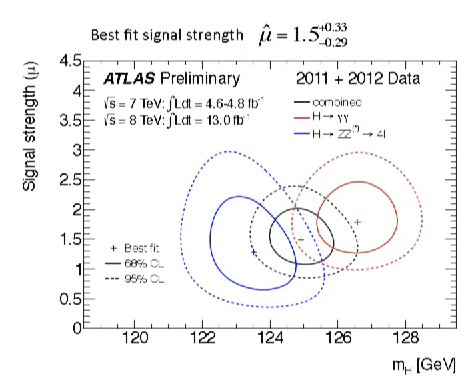Posted: Dec 18, 2012 12:34 am
http://resonaances.blogspot.be/2012/12/twin-peaks-in-atlas.html

Twin Peaks in ATLAS
For the annual December CERN council meeting the ATLAS experiment provided an update of the Higgs searches in the γγ and ZZ→4 leptons channels. The most interesting thing about the HCP update a month ago was why these most sensitive channels were *not* updated (also CMS chose not to update γγ). Now we can see why. The ATLAS analyses in these channels return the best fit Higgs masses that differ by more than 3 GeV: 123.5 GeV for ZZ and 126.6 GeV for γγ, which is much more than the estimated resolution of about 1 GeV. The tension between these 2 results is estimated to be 2.7σ. Apparently, ATLAS used this last month to search for the systematic errors that might be responsible for the discrepancy but, having found nothing, they decided to go public.
One may be tempted to interpret the twin peaks as 2 separate Higgs-like particles. However in this case they most likely signal a systematic problem rather than interesting physics. First, it would be quite a coincidence to have two Higgs particles so close in mass (I'm not aware of a symmetry that could ensure it). Even if the coincidence occurs, it would be highly unusual that one Higgs decays dominantly to ZZ and the other dominantly to γγ, each mimicking pretty well the standard Higgs rate in the respective channel. Finally, and most importantly, CMS does not see anything like that; actually their measurements give a reverse picture. In the ZZ→4l channel CMS measures mh=126.2±0.6 GeV, above (but well within the resolution) the best fit mass they find in the γγ channel which is 125.1±0.7 GeV GeV. That makes us certain that down-to-earth reasons are responsible for the double vision in ATLAS, the likely cause being an ECAL calibration error, an unlucky background fluctuation, or alcohol abuse.
